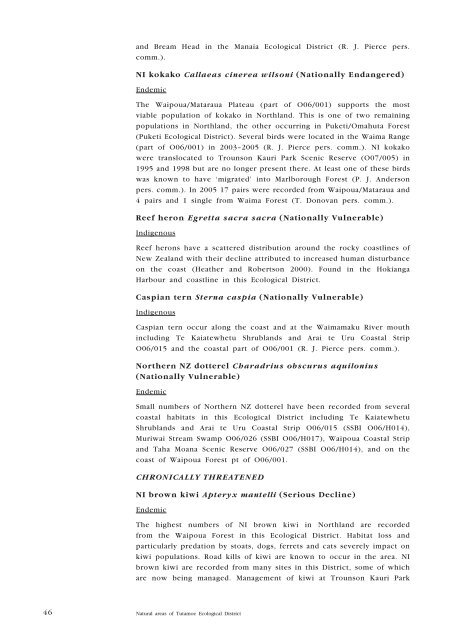Natural areas of Tutamoe Ecological District (3. Ecological character)
Natural areas of Tutamoe Ecological District (3. Ecological character)
Natural areas of Tutamoe Ecological District (3. Ecological character)
Create successful ePaper yourself
Turn your PDF publications into a flip-book with our unique Google optimized e-Paper software.
and Bream Head in the Manaia <strong>Ecological</strong> <strong>District</strong> (R. J. Pierce pers.<br />
comm.).<br />
NI kokako callaeas cinerea wilsoni (Nationally Endangered)<br />
Endemic<br />
The Waipoua/Mataraua Plateau (part <strong>of</strong> O06/001) supports the most<br />
viable population <strong>of</strong> kokako in Northland. This is one <strong>of</strong> two remaining<br />
populations in Northland, the other occurring in Puketi/Omahuta Forest<br />
(Puketi <strong>Ecological</strong> <strong>District</strong>). Several birds were located in the Waima Range<br />
(part <strong>of</strong> O06/001) in 2003–2005 (R. J. Pierce pers. comm.). NI kokako<br />
were translocated to Trounson Kauri Park Scenic Reserve (O07/005) in<br />
1995 and 1998 but are no longer present there. At least one <strong>of</strong> these birds<br />
was known to have ‘migrated’ into Marlborough Forest (P. J. Anderson<br />
pers. comm.). In 2005 17 pairs were recorded from Waipoua/Mataraua and<br />
4 pairs and 1 single from Waima Forest (T. Donovan pers. comm.).<br />
Reef heron egretta sacra sacra (Nationally Vulnerable)<br />
Indigenous<br />
Reef herons have a scattered distribution around the rocky coastlines <strong>of</strong><br />
New Zealand with their decline attributed to increased human disturbance<br />
on the coast (Heather and Robertson 2000). Found in the Hokianga<br />
Harbour and coastline in this <strong>Ecological</strong> <strong>District</strong>.<br />
Caspian tern Sterna caspia (Nationally Vulnerable)<br />
Indigenous<br />
Caspian tern occur along the coast and at the Waimamaku River mouth<br />
including Te Kaiatewhetu Shrublands and Arai te Uru Coastal Strip<br />
O06/015 and the coastal part <strong>of</strong> O06/001 (R. J. Pierce pers. comm.).<br />
Northern NZ dotterel charadrius obscurus aquilonius<br />
(Nationally Vulnerable)<br />
Endemic<br />
Small numbers <strong>of</strong> Northern NZ dotterel have been recorded from several<br />
coastal habitats in this <strong>Ecological</strong> <strong>District</strong> including Te Kaiatewhetu<br />
Shrublands and Arai te Uru Coastal Strip O06/015 (SSBI O06/H014),<br />
Muriwai Stream Swamp O06/026 (SSBI O06/H017), Waipoua Coastal Strip<br />
and Taha Moana Scenic Reserve O06/027 (SSBI O06/H014), and on the<br />
coast <strong>of</strong> Waipoua Forest pt <strong>of</strong> O06/001.<br />
chrOnIcAlly threAtened<br />
NI brown kiwi Apteryx mantelli (Serious Decline)<br />
Endemic<br />
The highest numbers <strong>of</strong> NI brown kiwi in Northland are recorded<br />
from the Waipoua Forest in this <strong>Ecological</strong> <strong>District</strong>. Habitat loss and<br />
particularly predation by stoats, dogs, ferrets and cats severely impact on<br />
kiwi populations. Road kills <strong>of</strong> kiwi are known to occur in the area. NI<br />
brown kiwi are recorded from many sites in this <strong>District</strong>, some <strong>of</strong> which<br />
are now being managed. Management <strong>of</strong> kiwi at Trounson Kauri Park<br />
46 <strong>Natural</strong> <strong>areas</strong> <strong>of</strong> <strong>Tutamoe</strong> <strong>Ecological</strong> <strong>District</strong>

















